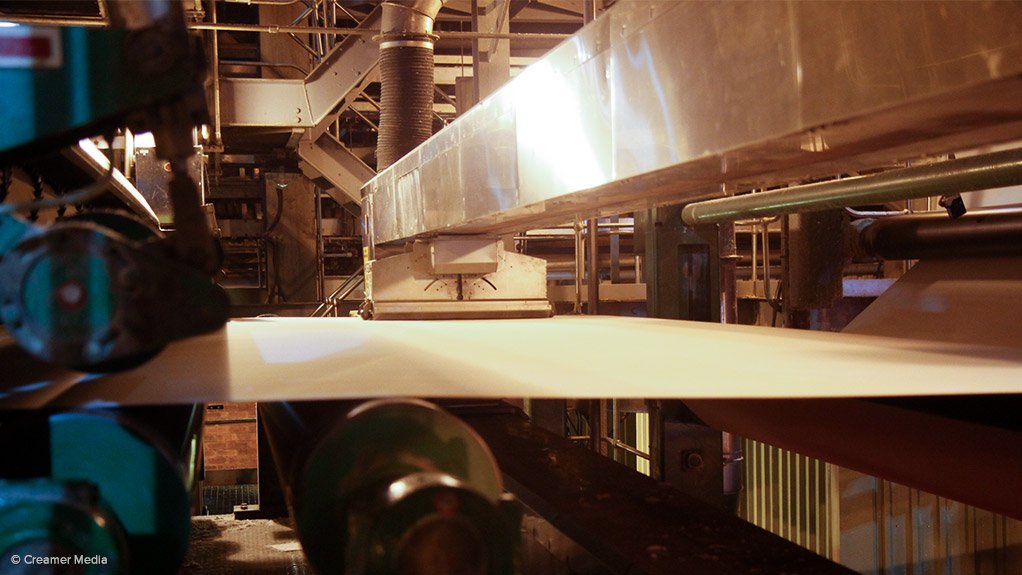Sappi off to a good start in FY22
Pulp and paper manufacturer Sappi has outperformed on guidance provided for the first quarter of its 2022 financial year.
Earnings before interest, taxes, depreciation and amortisation (Ebitda) increased by 36% quarter-on-quarter to $240-million and more than doubled compared with the same quarter in the prior financial year.
Profit in the reporting quarter amounted to $123-million, against a loss of $17-million posted in the corresponding quarter of the 2021 financial year.
CEO Steve Binnie attributes the improved performance to robust market demand in all product segments, combined with implementation of high sales prices, which helped to offset rising input costs and happened despite logistical bottlenecks.
He expects more earnings growth in the second quarter.
MARKET FEATURES
Global logistical challenges continued unabated and posed headwinds for Sappi’s export sales and raw material procurement in all regions.
Substantial energy, raw material and delivery cost inflation in the quarter was offset by selling price increases in the paper business.
Pulp sales volumes increased by 48% compared with the preceding quarter, as the company secured more shipping capacity, albeit at a higher cost, for its South African exports.
The hardwood dissolving pulp (DP) market price decreased to $905/t on the back of weakening viscose staple fibre (VSF) demand and pricing in China.
VSF prices rebounded towards the end of the quarter, however, which stabilised DP pricing.
Sappi’s three DP mills were fully sold in the quarter under review.
Binnie says markets for packaging and speciality papers continued to be robust across all regions, with sales volumes up 26% on a year ago.
“The successful implementation of price increases, combined with product mix optimisation, led to further progress in profitability for the segment,” he explains.
Buoyant demand for graphic papers boosted sales volumes by 20% compared with last year and provided support for price increases, which were necessary to offset significant cost inflation and restore Ebitda margins for the segment.
Notably, all assets ran at full operating capacity during the reporting quarter.
Renewed strong demand in domestic and export markets supported price increases across all paper grades and facilitated the return of the European business to profitability.
An unprecedented surge in energy prices for gas, power and coal forced Sappi to implement an energy surcharge on all European products. This extraordinary measure was a key component of Sappi’s strategy to offset the escalating energy costs and restore margins in the European business.
The North American region delivered a record first-quarter Ebitda of $89-million, which was more than triple the prior year. This achievement was despite significantly higher costs.
The year-on-year profitability of the South African business was positively impacted on by improved sales volumes and pricing in all segments.
Binnie confirms that Ebitda from South Africa was 46% higher than the prior quarter despite significant cost increases and logistical challenges.
Meanwhile, he notes that demand for DP continues to be strong and that VSF pricing and operating rates improved in January – which stabilised DP market prices at $905/t ahead of the Chinese New Year.
“An extremely high differential between cotton and VSF prices should support fibre substitution in future quarters which would be positive for DP demand and pricing. Additionally, the addition of breakbulk shipping is expected to aid in the reduction of the DP sales backlog.”
Sappi reports that the recovery of sales for graphic papers across all regions, combined with industry capacity closures, has tightened the market balance.
Additionally, the underlying demand in the packaging and speciality papers segment remains robust.
“The stronger markets for all our paper products should support price increase realisation, which is necessary to offset extraordinarily high input costs.
“Global logistical challenges and vessel shortages are likely to continue through the 2022 financial year, and our objective is to secure sufficient transport capacity to support the strong demand for our products and optimise delivery costs,” Binnie states.
Timber, pulp, chemicals, energy and delivery costs are expected to remain at elevated levels throughout the current financial year.
Specifically, in South Africa the higher delivery, timber and chemical prices will impact the margins for the pulp business.
Article Enquiry
Email Article
Save Article
Feedback
To advertise email advertising@creamermedia.co.za or click here
Comments
Press Office
Announcements
What's On
Subscribe to improve your user experience...
Option 1 (equivalent of R125 a month):
Receive a weekly copy of Creamer Media's Engineering News & Mining Weekly magazine
(print copy for those in South Africa and e-magazine for those outside of South Africa)
Receive daily email newsletters
Access to full search results
Access archive of magazine back copies
Access to Projects in Progress
Access to ONE Research Report of your choice in PDF format
Option 2 (equivalent of R375 a month):
All benefits from Option 1
PLUS
Access to Creamer Media's Research Channel Africa for ALL Research Reports, in PDF format, on various industrial and mining sectors
including Electricity; Water; Energy Transition; Hydrogen; Roads, Rail and Ports; Coal; Gold; Platinum; Battery Metals; etc.
Already a subscriber?
Forgotten your password?
Receive weekly copy of Creamer Media's Engineering News & Mining Weekly magazine (print copy for those in South Africa and e-magazine for those outside of South Africa)
➕
Recieve daily email newsletters
➕
Access to full search results
➕
Access archive of magazine back copies
➕
Access to Projects in Progress
➕
Access to ONE Research Report of your choice in PDF format
RESEARCH CHANNEL AFRICA
R4500 (equivalent of R375 a month)
SUBSCRIBEAll benefits from Option 1
➕
Access to Creamer Media's Research Channel Africa for ALL Research Reports on various industrial and mining sectors, in PDF format, including on:
Electricity
➕
Water
➕
Energy Transition
➕
Hydrogen
➕
Roads, Rail and Ports
➕
Coal
➕
Gold
➕
Platinum
➕
Battery Metals
➕
etc.
Receive all benefits from Option 1 or Option 2 delivered to numerous people at your company
➕
Multiple User names and Passwords for simultaneous log-ins
➕
Intranet integration access to all in your organisation





















